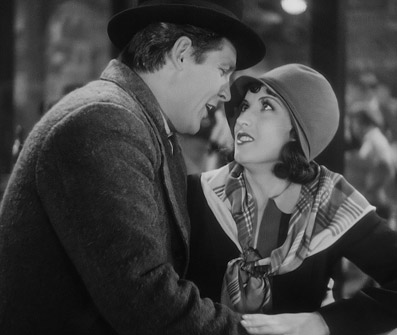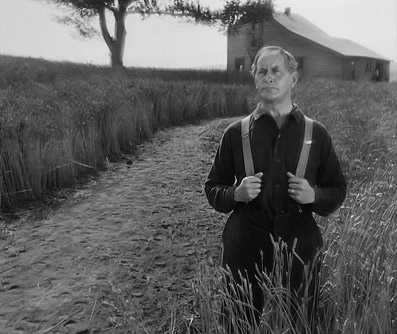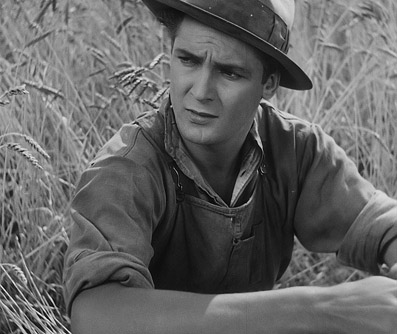|
Now here's an odd thing. A number of people I know have recently expressed their admiration for film sequences – particularly opening scenes as it happens – which are devoid of dialogue and tell the story in purely visual terms, There Will Be Blood being the most commonly quoted example. But ask them how many films they've watched recently that were made in the silent era, a time when the entire story had to be told in this manner, and they tend to get evasive, shifting their gaze and talking about how busy they've been and, well, these films are awfully old, aren't they. Which is a shame, because impressive as those first twelve minutes of Paul Thomas Anderson's compelling drama of oil and obsession are, there's little there that the likes of Ernest Lubitsch, Fritz Lang or F.W. Murnau weren't doing every bit as confidently back in the 1920s, and without a hundred years of cinema to draw on for inspiration. That's not meant as a dig at Mr. Anderson, no sir, but a small reminder of just how much of the current film language was firmly in place even before the arrival of synchronised sound.
This is especially evident in the work of Friedrich Wilhelm Murnau, particularly his 1924 Der letzt Mann [The Last Laugh], which dispensed with the use of intra-titles to tell an emotionally compelling story solely though the use of camera. performance and editing. You only need to be an irregular visitor here to have picked up on my enthusiasm for this particular filmmaker, and I'm far from alone in my opinion. Having been stunned in my youth by Nosferatu, his ground-breaking 'free adaptation' of Bram Stoker's Dracula, I've tended to approach subsequent DVD releases of his films with the eyes of an explorer opening a series of treasure chests, and have often been left wide-eyed with wonder at the jewels that lay within.

Made immediately after Murnau's first American film, Sunrise, which is widely and rightly acknowledged as one of the greatest works of the silent era, City Girl is in some respects its stylistic and thematic opposite, a cinematically reserved work in which the city girl of the title is quickly established as the moral flipside of the sophisticated metropolitan temptress of the earlier film. Whereas in Sunrise the farm boy was lured to the bright lights and pushed towards murder by the woman he had fallen for, the title character here – pretty but poor waitress Kate – is genuinely smitten with farm boy Lem, who has come to the city of his own volition to sell the family's annual wheat crop. The two hit it off immediately when Lem visits the busy lunch counter at which Kate works, and it only takes a second encounter for him to start dropping hints about a possible future together, but in that way that couples who aren't quite couples have of dancing round the point, neither will come out and express their true feelings for each other. Lem thus heads for the train station and Kate stays in her low paid job, but a synchronous moment of realisation sees them both chase after the other and meet up only by chance. A short while later they're married and heading back to Lem's family for an idyllic life as newlyweds. Oh, if only it were that simple.
Lem's father, a sternly religious man who is obsessively protective of his wheat crop right down to the last ear, was unsure about sending his son to the city alone in the first place and reacts with horror at the news of Lem's marriage, or rather that he has hooked up a lowly waitress (a prejudice captured graphically when the word 'waitress' leaps damningly from the letter in which Lem breaks the news). The couple's new found happiness thus lasts only until they enter the family home, where Lem quickly resubmits to his father's subjugation and Kate is treated as an unwelcome invader, becoming the object of leering fascination for farmhands she is pressured by her new father-in-law to wait on.
Now while little of this is likely to prove that surprising to a modern audience, particularly given the overuse of this premise in various guises in the decades that followed, it's important to remember that City Girl was made when the storyline, though far from new, was nothing like as well-worn as it subsequently became. Its continuing strength lies not in the originality of its story but the manner in which it is told – this is late career Murnau at his most cinematically restrained, with little evidence of the expressive camera moves and trick photography which helped to make Sunrise one of the most widely discussed films of the silent era. Here he seems determined to hold back on the very techniques he helped to develop and to instead demonstrate his considerable skills with framing, mise-en-scène, montage and performance, the traditional building blocks of cinema storytelling.
As David Kalat astutely observes in his commentary, Murnau is more comfortable with the American setting here than he was in Sunrise. He certainly makes strong use of his locations, many of which – the busy lunch counter, the mid-western family farm, the one-room city apartment located right next to the L-track – would go on to become icons of American film drama. The surface simplicity of the story structure still allows for some subtextual sophistication, particularly in the use of recurring and opposing motifs to reinforce the similarities between Kate's life in the city and the one she has innocently married into. The mechanical caged bird that is her prized possession, meanwhile, is symbolic both of the countryside she yearns to move to and the artificiality and restrictions of her urban existence, yet for Lem's young sister Marie it's an exciting reflection of the modernity that Kate represents. The expressionist touches are still there – the sudden backward dolly shot that allows the bustle of the city to overwhelm Lem, or the electrifying sweep with the newlyweds as they run through the wheat fields – and are rendered even more striking by their comparative rarity, while the gorgeously shot and edited harvesting sequence has a documentary poetry that vividly expresses Murnau's original desire to produce "a symphony of wheat."

As with Sunrise, it's the actors who give the drama its heart, and despite David Torrence's emphasised broodiness as Lem's father and a couple of old-school casting decisions (the gnarly-faced reaper and Kate's vamp of a boss, though both lovely in themselves, feel a little like leftovers from an earlier cinematic age), there's an unforced naturalism to many of the performances that illustrates how late silent cinema was starting to shake off its melodramatic past and becoming acutely aware of the subtle power of the two-shot and the facial close-up. This is particularly true of lead players Charles Farrell and Mary Duncan, who in those two early extended lunch counter exchanges enchantingly sell the authenticity of their lightning romance.
Whether City Girl is an unsung Murnau masterpiece that can hold its own alongside Sunrise, Faust and Der leztz Mann is another matter. It is, after all, a sometimes dialogue driven story in a now very familiar vein, one whose climactic events are shaped by the approach of a storm that, unlike the one in Victor Sjöström's similarly themed 1928 The Wind, fails to convincingly materialise. But this is still an enthralling told and delicately nuanced tale, one whose fascination lies not just in its location in Murnau's extraordinary oeuvre, but in the consistently assured and subtly imaginative manner in which it unfolds.
Now this, good people, is why we made the upgrade to Blu-ray.
Many people seem to have erected a number of self-imposed barriers to engaging with silent films – the lack of dialogue and sound effects, the over-expressive acting, the fact that they're in black and white rather than colour, and so on (they're also not in 3D of course, another hurdle in the making). But working deep down at an almost subconscious level is also the expectation that the image quality will fall hopelessly short of what we've come to unreasonably expect as the norm in a high definition age, one lacking in stability and blighted by dirt and damage. This image of silent cinema as universally damaged is not born from ignorance, I should add, but memories of how all such films used to look when we first saw them on TV or video. But things have changed. Oh my have they. The discovery of better preserved prints and the phenomenal restoration work that has been made possible through current digital techniques have completely transformed some films from this era and allowed us to view them as close to dammit as they were originally intended to be seen. Combine this with the the higher definition offered by Blu-ray and we just knew it would only be a matter of time before a transfer appeared that confirmed beyond all doubt that film shot back in the 20s or 30s could look every bit as good as its modern equivalent. The recently discovered Czech print on the Masters of Cinema Blu-ray of Sunrise and the same company's Blu-ray restoration of M came within a hair's breadth, but now we have Murnau's original silent version of City Girl, and watching it unfold in high definition I had to repeatedly prod my dropped jaw closed and my eyes back into my head.
Once again Masters of Cinema have reset the bar for future silent film transfers. OK, we can pretty much take it for granted that no film from this period, particularly one that was for years thought lost, is going to look pristine, at least for now. Yes, there are some variations in contrast, some brightness flickering, a little picture instability, very visible film grain, and even the odd bit of dirt and damage. But the best material – and there's a lot of it here – is frankly stunning, with the level of detail exceeding all expectations and on at least two occasions actually contributing to the mise-en-scène, revealing tiny but tell-tale tufts of wear on Lem's jacket that tell us as much about his travel experience as his bumbling inability to locate his ticket, and a small dusting of soot that the passing L-trains have deposited on Kate's hardy pot-plant. The tonal range is lovely, with no contrast compromises made to retain solid black levels and stable whites, with the greyscale between having an almost steely richness. Some of the most striking examples are in the harvesting sequence, where the fine detail of the facial texture, clothing and grain sacks clearly is visible. I was listening to the commentary on this very disc when I was visited by a friend who had not seen any of the above-mentioned restorations from Eureka and who was rooted to the spot by what she saw, remarking sincerely, "This looks like it was shot yesterday." Astonishingly, this 20th Century Fox sourced print has undergone no major digital restoration, the reason given being that the process resulted in "noticeable disruption of the tonal quality belonging to the image in many scenes."

click here for a full-sized grab
The film is accompanied by a new 2008 score, composed and arranged by Christopher Caliendo. As my reviewing colleague Camus rightly pointed out when I was showing him extracts from this very disc, any such score is beyond the director's control and for all we know could be contrary to his wishes or intentions. But such is the fate of all silent cinema and the music here certainly doesn't distract from the image, despite a lean towards hoedown for the farm scenes. The quality of the recording is, as you'd expect, excellent, with the 5.1 DTS-HD Master Audio track delivering a lovely fullness and clarity.
The key on-disc extra is a commentary track by American film historian and author David Kalat, the man who provided such comprehensive commentary tracks for Eureka's recent Mabuse box set. Like his English counterpart, Bey Logan, Kalat's considerable appeal as a commentator lies in his encyclopaedic knowledge of his subject and the infectious enthusiasm of his delivery. Although crammed to the gills with facts and opinion, this never feels like an academic piece and really does expand your knowledge and appreciation of the film, providing a small book's worth of background information on its production and the key figures involved. Areas covered, often in detail, include the film's relationship to Sunrise, the changes made to the Elliot Lester's source play The Mud Turtle, the use of tickets and documents to propel the story forward, how the studio created the wheat farm (this is a good one), a clear explanation of how Hollywood dealt with the import of foreign films and dominated distribution, Murnau's career in America, the differences between the silent and sound version (which Murnau had nothing to do with), the similarities with Terence Mallick's later Days of Heaven, the actors, the original ending, and loads more. Kalat even provides recommendations for further reading at the end. Terrific stuff.
The accompanying Booklet only has one essay, Reaching Beyond the Frame by Adrian Danks, but includes plenty of high quality stills, credits and notes on the restoration.
A simple story, captivatingly told, and a must-have for all Murnau and silent cinema devotees, not least for the gorgeous quality of the transfer and the excellent commentary. Masters of Cinema have taken a bit of a risk releasing this on Blu-ray only, but when the film looks as good as it does here I can fully understand their reluctance to downgrade it to DVD (seriously, could you imagine saying that a few years ago?). If you have the gear then this is one of those discs you can use to show it off, if not and you're serious about classic cinema then I'd start planning that upgrade. Highly recommended.
|